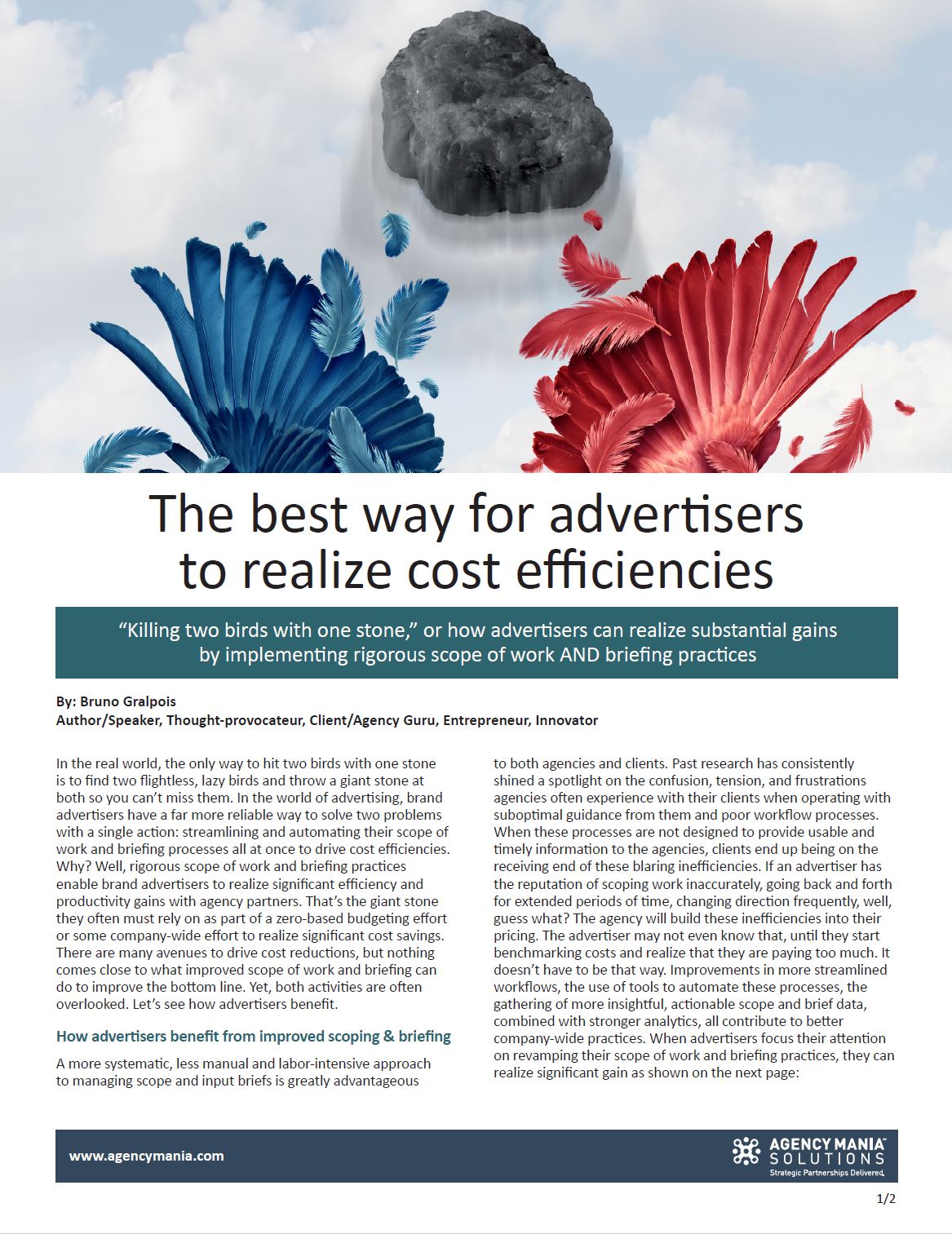“Killing two birds with one stone,” or how advertisers can realize substantial gains by implementing rigorous scope of work AND briefing practices
In the real world, the only way to hit two birds with one stone is to find two flightless, lazy birds and throw a giant stone at both so you can’t miss them. In the world of advertising, brand advertisers have a far more reliable way to solve two problems with a single action: streamlining and automating their scope of work and briefing processes all at once to drive cost efficiencies. Why? Well, rigorous scope of work and briefing practices enable brand advertisers to realize significant efficiency and productivity gains with agency partners. That’s the giant stone they often must rely on as part of a zero-based budgeting effort or some company-wide effort to realize significant cost savings. There are many avenues to drive cost reductions, but nothing comes close to what improved scope of work and briefing can do to improve the bottom line. Yet, both activities are often overlooked. Let’s see how advertisers benefit.
Download a print-friendly version here
How advertisers benefit from improved scoping & briefing

A more systematic, less manual and labor-intensive approach to managing scope and input briefs is greatly advantageous to both agencies and clients. Past research has consistently shined a spotlight on the confusion, tension, and frustrations agencies often experience with their clients when operating with suboptimal guidance from them and poor workflow processes. When these processes are not designed to provide usable and timely information to the agencies, clients end up being on the receiving end of these blaring inefficiencies. If an advertiser has the reputation of scoping work inaccurately, going back and forth for extended periods of time, changing direction frequently, well, guess what? The agency will build these inefficiencies into their pricing. The advertiser may not even know that, until they start benchmarking costs and realize that they are paying too much. It doesn’t have to be that way. Improvements in more streamlined workflows, the use of tools to automate these processes, the gathering of more insightful, actionable scope and brief data, combined with stronger analytics, all contribute to better company-wide practices. When advertisers focus their attention on revamping their scope of work and briefing practices, they can realize significant gain as shown below:
Ingredients for a successful implementation
The benefits are within reach. Automated scope of work and briefing solutions are gaining strong momentum among advertisers of all sizes because they provide them with rigorous enterprise-wide solutions to managing the many moving parts of marketing plans and deliverables, agency financial commitments, and the use of the resources needed to bring it all together. Everyone is eager to roll out these solutions and it’s time to move into execution mode. What are the success ingredients every advertiser should secure for a successful implementation and roll out? Years of practice led us to narrow down the list to a few select ones:
- Ensure clarity on the business processes, requirements, success metrics, and proposed solution up front. It means spending quality time capturing input from various internal teams and stakeholders before getting into launch mode.
- Strong project management, resource commitments, and communication. Advertisers must make resources (marketing and procurement) available to answer questions, drive decisions, and test the solution according to an agreed upon schedule.
- Executive buy-in and support. Transitioning to an enterprise solution requires commitment from the leadership team to overcome internal entropy and make comprehensive and timely decisions, particularly around internal company standardization.
- Attention to change management and communication plan. Key stakeholders in marketing and procurement need to be consulted and involved in the planning and implementation. Users must be well-trained and provided proper context and motivation. No one should be surprised by the change, and they should feel well-prepared.
- Continuous improvement with an eye towards greater efficiency and better ROI. Business needs change and better ideas come as users get more familiar with new processes and systems. To be successful in the long term, any solution must be changeable and adaptable.
The cost efficiencies associated with implementing well-structured, streamlined scopes of work and briefing practices are substantial and range from productivity gains through less duplication of efforts, better resource allocation, and negotiation leverage. Other benefits include greater transparency, accelerated go-to-market, improved decision making, and greater integration with other agency management processes like performance evaluations. This also leads to better effectiveness, by focusing on the right type of work. Some say that the only way to kill two birds with one stone is to pick up the stone after each shot and rethrow it. It’s true that some advertisers solve both problems sequentially, often starting with scope management (big picture) and then going on to revamp their briefing practices (the smaller picture). Management consultant and author Peter Drucker once said, “Efficiency is doing things right; effectiveness is doing the right things.” The right scope of work and briefing practices can help you achieve both.
By Bruno Gralpois
Author/Speaker, Thought-provocateur, Client/Agency Guru, Entrepreneur, Innovator







